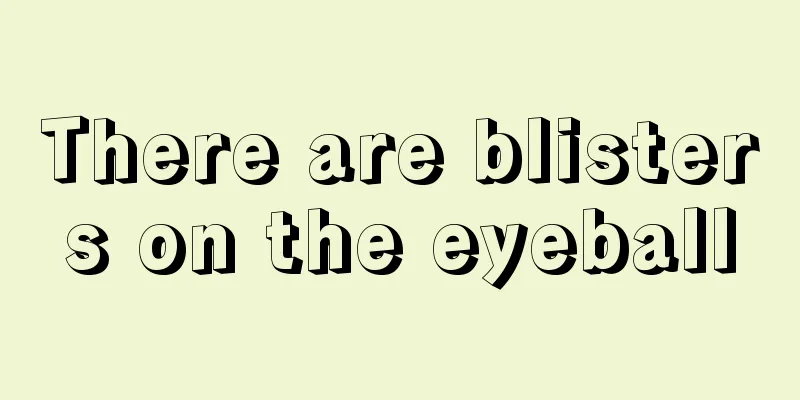There are blisters on the eyeball

|
The eyes are the windows to the soul and are very important in normal times. The eyes cannot be harmed in the slightest, otherwise it will cause a lot of trouble. When people find blisters on their eyeballs, they should consider whether foreign objects have entered the eyes recently or whether the cornea is inflamed, and whether they feel any discomfort other than blisters. After finding the cause, they should treat it. General examination Eyelid examination: usually performed by inspection and palpation under natural light. Main observations: ① Whether there are congenital abnormalities of the eyelids, such as eyelid coloboma, narrow palpebral fissure, ptosis, etc. ② Abnormalities of the eyelid skin, such as redness, swelling, heat, pain, subcutaneous emphysema, lumps, etc. ③ Abnormal eyelid position, such as comparing the width of the bilateral palpebral fissures and whether the eyelids are everted inside or outside. ④ Abnormalities of eyelid margin and eyelashes. Lacrimal apparatus examination: includes lacrimal gland and lacrimal duct. Check for lumps in the lacrimal gland area, pay attention to whether the lacrimal puncta are everted or blocked, whether there is redness, swelling, tenderness, and fistula in the lacrimal sac area, and whether there is secretion overflowing from the lacrimal puncta when squeezing the lacrimal sac. Use instruments to check the amount of tear secretion and whether the lacrimal duct is narrowed or blocked. Conjunctival examination: Pay attention to the color, smoothness and transparency of the conjunctiva, and the presence of congestion, edema, papillary hyperplasia, follicles, scars, ulcers and new masses, etc. Examination of the eyeball and eye socket: During the examination, attention should be paid to the size, shape, position and movement of the eyeball, and whether there is involuntary nystagmus. Anterior segment examination of the eye: including examination of the cornea, anterior segment of the sclera, anterior chamber, iris, pupil, and lens. Corneal examination: Pay attention to the size, transparency, surface smoothness, new blood vessels, curvature and perception of the cornea. Scleral examination: Pay attention to whether the sclera is yellow, nodules, congestion and tenderness. Anterior chamber examination: pay attention to the depth of the anterior chamber and whether the aqueous humor is turbid, has blood, pus, foreign matter, etc. Iris examination: Pay attention to the color and texture of the iris, the presence of neovascularization, atrophy, nodules, cysts, adhesions, and the presence of iris root detachment, defects, tremors, and bulging. Pupil examination: Pay attention to the size, position, and shape of the pupil, the presence of exudate, organized membrane, and pigment in the pupil area, and the presence of direct light reflex, indirect light reflex, and near reflex of the pupil. Lens inspection: Note the crystal clarity, position, and presence of crystals. Check significance Eye examination is an important part of the physical examination. The most common problem among young people is refractive error (abnormal vision in both eyes when the vision is not corrected or is incorrectly corrected). Such people should see a doctor, have their eyes tested and get glasses as soon as possible. Among middle-aged and elderly people, the most common eye problems are cataracts and retinal arteriosclerosis. Cataracts are often caused by aging, which is the clouding of the lens as we age. According to statistics, 100% of people over 80 years old have this condition. If cataracts occur before the age of 50, you should consider whether there are other factors affecting them and seek medical attention actively. Changes in the retinal arteries can reflect the degree of arteriosclerosis in the body. They often occur in people aged 50 to 60 or above, and often coexist with hypertension and diabetes. According to statistics, 70% of patients with hypertension may experience retinal artery changes, so this is also a criterion for judging the severity of hypertension; severe diabetic patients also have fundus changes. Therefore, patients with hypertension and diabetes should undergo routine fundus examinations. |
<<: The dangers of eye twitching
>>: The left eyeball protrudes more than the right eyeball
Recommend
How to remove oil stains from cotton clothes
If we want to remove oil stains on cotton-padded ...
The method of making garlic soybean sauce is like this
Garlic soybean paste is a sauce that people like ...
Is there an impact of meningitis vaccination
As the name suggests, meningitis is a disease cau...
What effect does pregnancy with ovarian tumor have on the baby?
Ovarian tumors can be benign or malignant. Two-th...
Hard pimples on back?
Whether it is acne or pimples, they will more or ...
There are 5 major signals to tell if your spleen and stomach are healthy
Traditional Chinese medicine believes that the bo...
What is considered high blood uric acid? What is the normal value
Blood uric acid is uric acid in the serum, which ...
What are the diagnostic methods for thyroid cancer
What are the diagnostic methods for thyroid cance...
Is a persistent cough a sign of lung cancer? Not necessarily
A persistent cough is not necessarily caused by l...
Acne on the nose
With the faster and faster development of moderni...
The harm of electrolyte to human body
Electrolytes are referred to differently in diffe...
Can Traditional Chinese Medicine prevent the recurrence of ovarian teratoma?
Ovarian teratoma is a common disease among female...
Can I eat before doing a chest CT scan?
When people have a physical examination, they usu...
What is water-based emulsion
Water-based lotion is a relatively common skin ca...
There are a lot of hairs on my face
Sweat hair is a kind of fine hair on the human bo...









